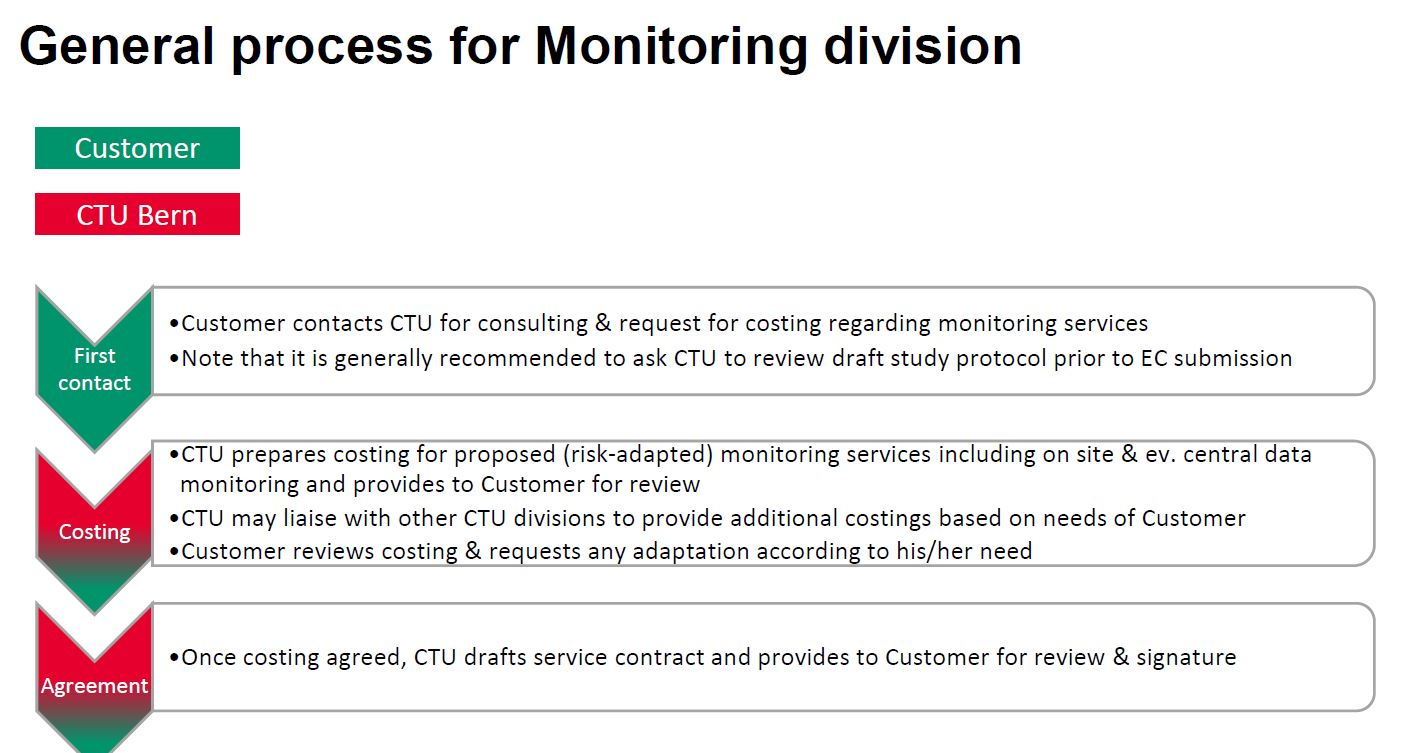Monitoring
CTU Bern offers quality control services (monitoring) to sponsors of single-center or multi-center clinical studies, including sponsor-investigators working at Inselspital or other institutions. We offer two services to ensure high quality of the studies you conduct:
Team members
Team members

- Name / Titel
- Zimmermann Martina, PhD
- Funktion
- Head of Monitoring
- martina.zimmermann@unibe.ch
- Phone
- +41 31 684 44 19

- Name / Titel
- Fuhrer Michela, MSc
- Funktion
- Clinical Trial Monitor
- michela.fuhrer@unibe.ch
- Phone
- +41 31 684 35 03

- Name / Titel
- Lippuner Johanna
- Funktion
- Junior Research Assistant (Monitoring)
- johanna.lippuner@unibe.ch
- Phone
- +41 31 684 59 22

- Name / Titel
- Lugarà Rosamaria, PhD
- Funktion
- Clinical Trial Monitor
- rosamaria.lugara@unibe.ch
- Phone
- +41 31 684 68 36

- Name / Titel
- Mahler Sarina
- Funktion
- Research Assistant
- sarina.mahler@unibe.ch

- Name / Titel
- Mermoud Sophie
- Funktion
- Deputy Head of Monitoring
- sophie.mermoud@unibe.ch
- Phone
- +41 31 684 59 33

- Name / Titel
- Naim Samara, Dr.
- Funktion
- Clinical Trial Monitor
- samara.naim@unibe.ch
- Phone
- +41 31 684 59 23

- Name / Titel
- Maier Julia Malaika, PhD
- Funktion
- Clinical Trial Monitor
- julia-malaika.maier@unibe.ch
- Phone
- +41 31 684 35 17

- Name / Titel
- Peña Zoé, Dipl.-Ing.
- Funktion
- Clinical Study Manager
- zoe.pena@unibe.ch
- Phone
- +41 31 684 45 74

- Name / Titel
- Raltschev Constanze, PhD
- Funktion
- Clinical Trial Monitor
- conny.raltschev@unibe.ch
- Phone
- +41 31 684 39 23

- Name / Titel
- Uebersax Nadine, MSc
- Funktion
- Clinical Trial Monitor
- nadine.uebersax@unibe.ch
- Phone
- +41 31 684 33 69

- Name / Titel
- Wirz Danielle, MSc
- Funktion
- Clinical Trial Monitor
- danielle.wirz@unibe.ch
- Phone
- +41 31 684 44 85
On-Site Monitoring
On-Site Monitoring
The on-site monitor provides quality control and assurance for clinical studies. The monitor visits study sites at regular intervals throughout the study, to ensure that the conduct of the study matches the protocol, applicable Standard Operating Procedures (SOPs), International Conference on Harmonization Good Clinical Practice (ICH-GCP) guidelines, and regulatory requirements. For multi-center studies, the monitor is an important point of contact between the sponsor and the center.
Central Data Monitoring
Central Data Monitoring
If you select central data monitoring, CTU Bern does centralized checks of accumulating study data. These are performed regularly through the study, and include range, plausibility, and consistency checks. Because some measures are based on statistical techniques, the Quality Assurance, Monitoring division, and Statistics and Methodology division collaborate closely. This process also involves on-site monitoring, because findings identified during central data monitoring may trigger on-site visits and vice versa.
Sequence of activities
Sequence of activities
Planning
Before we can monitor a clinical study, a dedicated monitoring plan will need to be written and approved by the study sponsor. CTU Bern will help you write this plan. It is the sponsor's responsibility to determine the extent and frequency of monitoring. However, CTU Bern can make suggestions based on your protocol and the CRFs. The monitoring plan will specify the kind of on-site visits that we carry out, how often these visits occur, and the amount of source data verification that we will perform on these visits.
The central data monitoring plan will define the extent of central data monitoring, including the types of checks that will be done. The plan is the product of a collaboration between the sponsor, a statistician, a central data monitor, and an on-site monitor and data management staff, if the latter are needed.
Pre-study visits
On these visits we assess the suitability of potential study sites (inspect facilities, meet with trial staff etc.)
Site Initiation Visits
- Meet with involved trial staff
- Train staff in study-specific details or specific aspects of GCP, e.g.:
- Trial design
- Endpoints
- Eligibility criteria
- Informed consent process
- Registration / randomization
- Trial treatment
- Drug accountability and handling
- CRFs
- AE and SAE reporting
- Review study files
Monitoring visits
- Check study progress
- Verify source data as described in the monitoring plan
- Resolve queries
- Check study drug accountability, as applicable
- Ensure compliance with protocol and regulatory requirements
- Train new trial staff
After every visit to the site, the monitor informs the sponsor and the site in writing of relevant findings made during the visit, and details corrective and preventive actions already taken, or recommendations made to the study site/sponsor.
Close-out visit
- Resolve any open queries
- Check study drug accountability, if applicable
- Final check of study files on site
- Information about handling of any remaining study drug and archiving timelines
Regular centralized data checks
Most checks will result in individual queries to a study site, but others might trigger on-site monitoring visits or direct contact between the study sponsor and the study site.
- Monitor recruitment rates to oversee the progress of the study and identify poorly performing study sites
- Check for signatures on electronic case report forms or missing values within and across study sites; remind study sites to sign forms and enter data; identify unreliable study sites
- Perform range checks of pre-specified data points; e.g., if a lab value is within a certain range (if not already implemented in the electronic case report form see Data Management)
- Perform plausibility checks, including comparisons of the same measure across time; ensure consistency across data points, such as checking that pregnancy is only recorded for female participants (if not already implemented in the electronic case report form see Data Management)
- Assess the distribution of numeric data within and across study sites to identify outlying data points (resulting in queries to confirm or correct a value) or outlying centers (could indicate differences in analytical methods)
- Employ statistical techniques to identify possible data fabrication, which will trigger on-site monitoring visits


